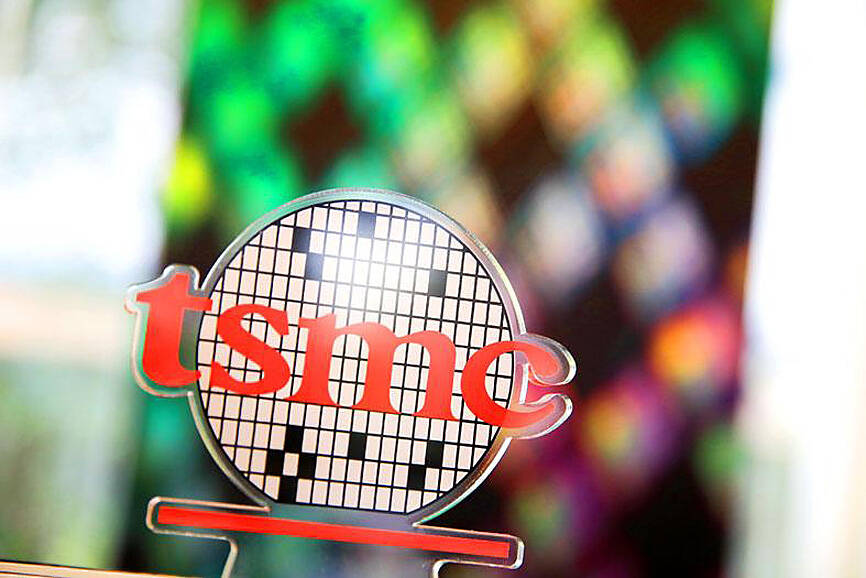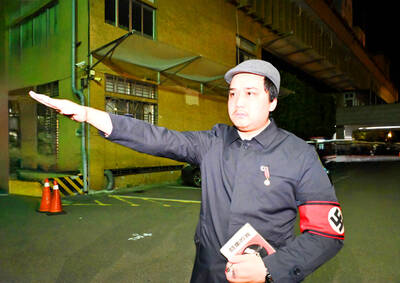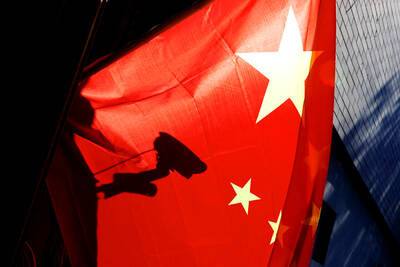Taiwan Semiconductor Manufacturing Co (TSMC, 台積電) is in discussions with the White House over potential US tariffs on semiconductors, seeking a solution that benefits both sides, a senior company executive said on Friday.
Speaking at a forum hosted by the US think tank Hudson Institute in Washington, TSMC senior vice president Peter Cleveland said that the company was maintaining close communication with US President Donald Trump’s administration and is optimistic that talks were moving in a “positive direction.”
Talks were ongoing, particularly concerning Taiwan’s extensive semiconductor manufacturing ecosystem and its exports to the US, he said.

Photo: I-hwa Cheng, Bloomberg
“And they’re listening,” he added.
However, TSMC was still uncertain about what will happen on Wednesday, when Trump is expected to introduce a slew of new tariffs.
To avoid the tariffs and appease Trump, who is eager to shift manufacturing to the US, TSMC has already made substantial investments in the country. The company on March 3 committed an additional US$100 billion to build three wafer fabrication plants, two advanced integrated circuit packaging facilities, and a research and development center, bringing its total investments in Arizona to US$165 billion.
At the forum, titled “Building a Sustainable and Successful Semiconductor Ecosystem under the Trump Administration,” other industry leaders also weighed in on the potential effect of the proposed tariffs.
Jonathan Hoganson, head of US government affairs at semiconductor equipment supplier ASML Holding NV, said that industry players hope the new policy will strengthen the ecosystem rather than create barriers.
Patrick Wilson, vice president of government relations at Hsinchu City-based smartphone IC designer MediaTek Inc (聯發科), underscored the importance of fostering a favorable business environment.
“We just want to have the right tariff or regulatory environment that makes it possible for our customers to win,” he said.
TSMC is seeking to start construction of its third advanced wafer fab in Arizona soon, Cleveland said.
“We have not started to break ground on our third wafer fab in Phoenix. We would like to start next week,” he said.
To begin construction, the company needs assistance from the US government, such as an environmental permit, he said.
While Taiwan remains the “home” of the contract chipmaker, the US was an “ideal location” for TSMC to extend its global footprint, Cleveland said.
TSMC aims to roll out high-end chips from plants in Arizona, and “we’re going to build those in Phoenix to sustain the US’ AI [artificial intelligence] leadership,” he said.
The first fab in Arizona has started production using the 4-nanometer process, while the second fab, which would use the 3-nanometer, 2-nanometer and A16 processes, is under construction and is expected to begin production in 2028.
The third, of which TSMC has said little to date, is expected to begin production by 2030, using the 2-nanometer or more advanced processes, the company said in April last year.
However, production in the US has not been easy, Cleveland said.
“The United States is a different marketplace. Labor costs are high,” he said.
Nevertheless, he highlighted TSMC’s “excellent” partnership with Washington, saying the company had a “good dialogue” with the US Department of Commerce about structural issues.
“We are optimistic about our collaboration and partnership going forward with the Trump administration as well as Capitol Hill,” he said.

SECURITY: As China is ‘reshaping’ Hong Kong’s population, Taiwan must raise the eligibility threshold for applications from Hong Kongers, Chiu Chui-cheng said When Hong Kong and Macau citizens apply for residency in Taiwan, it would be under a new category that includes a “national security observation period,” Mainland Affairs Council (MAC) Minister Chiu Chui-cheng (邱垂正) said yesterday. President William Lai (賴清德) on March 13 announced 17 strategies to counter China’s aggression toward Taiwan, including incorporating national security considerations into the review process for residency applications from Hong Kong and Macau citizens. The situation in Hong Kong is constantly changing, Chiu said to media yesterday on the sidelines of the Taipei Technology Run hosted by the Taipei Neihu Technology Park Development Association. With

A US Marine Corps regiment equipped with Naval Strike Missiles (NSM) is set to participate in the upcoming Balikatan 25 exercise in the Luzon Strait, marking the system’s first-ever deployment in the Philippines. US and Philippine officials have separately confirmed that the Navy Marine Expeditionary Ship Interdiction System (NMESIS) — the mobile launch platform for the Naval Strike Missile — would take part in the joint exercise. The missiles are being deployed to “a strategic first island chain chokepoint” in the waters between Taiwan proper and the Philippines, US-based Naval News reported. “The Luzon Strait and Bashi Channel represent a critical access

‘FORM OF PROTEST’: The German Institute Taipei said it was ‘shocked’ to see Nazi symbolism used in connection with political aims as it condemned the incident Sung Chien-liang (宋建樑), who led efforts to recall Democratic Progressive Party (DPP) Legislator Lee Kun-cheng (李坤城), was released on bail of NT$80,000 yesterday amid an outcry over a Nazi armband he wore to questioning the night before. Sung arrived at the New Taipei City District Prosecutors’ Office for questioning in a recall petition forgery case on Tuesday night wearing a red armband bearing a swastika, carrying a copy of Adolf Hitler’s Mein Kampf and giving a Nazi salute. Sung left the building at 1:15am without the armband and apparently covering the book with a coat. This is a serious international scandal and Chinese

COUNTERINTELLIGENCE TRAINING: The ministry said 87.5 percent of the apprehended Chinese agents were reported by service members they tried to lure into becoming spies Taiwanese organized crime, illegal money lenders, temples and civic groups are complicit in Beijing’s infiltration of the armed forces, the Ministry of National Defense (MND) said in a report yesterday. Retired service members who had been turned to Beijing’s cause mainly relied on those channels to infiltrate the Taiwanese military, according to the report to be submitted to lawmakers ahead of tomorrow’s hearing on Chinese espionage in the military. Chinese intelligence typically used blackmail, Internet-based communications, bribery or debts to loan sharks to leverage active service personnel to do its bidding, it said. China’s main goals are to collect intelligence, and develop a